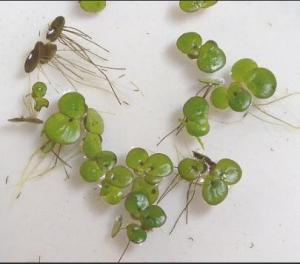We have created a check list of considerations and actions to take if duckweed is growing on the surface of your pond:
- Duckweed can survive a PH range from 5 to 9 and grows well between 6.5 and 7.5
- If the PH is below 7.0 ammonia can be kept in its ionized state as ammonium which is the preferred form of nitrogen for duckweed growth. Consider taking actions to raise the PH level.
- Reducing surface coverage by aeration or harvesting will release carbon dioxide levels to raise PH.
- Duckweed grows rapidly when potassium is available.
- Depletion of nutrients will cause duckweed to stop growing.
- Duckweed may contain up to 45% protein and high in vitamin A.
- Duckweed colonies are nutrient sinks. They can remove nitrogen, phosphorus, calcium, sodium, potassium, carbon, and magnesium from pond water.
- The length of the legs extending from the leaf is an indicator for nutrient availability, short legs- excess nutrients, long legs (+ 1 inch) – limited nutrients.
- Duckweed surface coverage will increase water temperature and water loss through transpiration.
- Duckweed plants can absorb and metabolize carbohydrates such as sucrose and glucose and nitrogenous compounds like urea and amino acids. Does your pond have leaves on the bottom slowly decaying?
- Treating duckweed with chemicals may cause a secondary release of nutrients as the plants expire.
- Deciduous leaves are a source of phosphorous and carbohydrates.
Reducing available nutrients will reduce duckweed and water meal growth
 Short leg length is a barometer for duckweed growth based on nutrients
Short leg length is a barometer for duckweed growth based on nutrients


